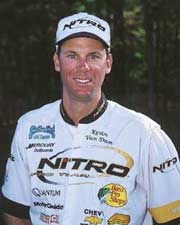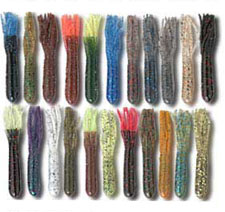Tubin' Spring Bass
Tubin' Spring Bass
Serious bass anglers know that spring is a time when fishing gets very consistent. The fish are relating to shallow water, and they're a lot more aggressive. Bass are in that shallow zone to feed and guard their nests. This makes them prone to bite a tube jig from the pre-spawn all the way through the post-spawn.
 Tracker Marine pro Kevin VanDam, of Kalamazoo, Mich., is one of the most dominant anglers on the pro tournament trail.
Tracker Marine pro Kevin VanDam, of Kalamazoo, Mich., is one of the most dominant anglers on the pro tournament trail.
The great thing about a tube lure is its action. Due to its unique shape and tentacles, the tube has a lot of movement. Every time you pick it up off of the bottom and hop it, it darts from one side to another. It really never goes to the same place twice. This erratic action triggers a lot of strikes.
We catch fish on tubes all year long, but bed fishing is different. You just drag it along real slow. Those tentacles on the tail move quite a bit, and it really makes those bass mad. They want to get it out of their nest. It takes very little movement for those tentacles to shift about in the water. So when a bass gets close to it, and if he's moving any water with his pectoral fins at all, the tube will have a lot of movement even when it's sitting still.
Tubes also trap air and let off a lot of bubbles, so there are a lot of things that they have going for them. Tubes may not look like they have a lot of action, but they do a bunch of the things that bass are looking for.
If you see and cast to a bedding fish from a distance, and he doesn't realize you're around, a lot of times he'll bite the tube on the very first cast. But many spawning fish we catch in the spring we don't actually see. The water is dirty or murky. When conditions are right in the lake -- the water temperature is in the mid-60s, there's a full moon, and you're around spawning fish -- work your bait carefully. If you make a cast into a spot that looks good, but you can't see the bottom or the fish, leave the tube in place a while to give the fish an opportunity to see it.
If you feel a bite, set the hook right away. You don't want to give the fish any chance to spit it out. The time is ticking, especially when bed fishing. When a bass bites, it’s typically removing the bait from the bed.
I use a 3/0 hook with the regular Kevin VanDam Pro Model tube, which is a 3 1/2-inch tube. I rig it weedless with a hook that Mustad makes especially for tubes; the Bigmouth Tube Hook. They make several different versions to accommodate every size tube.
 Buy the Kevin Van Dam's Pro Model Tube
Buy the Kevin Van Dam's Pro Model Tube
I put a slip sinker in front of the tube, and try to leave the sinker loose most of the time. If there's a lot of grass or bushes you need to make the lure fall down into, I may peg the sinker. I really like the Lake Fork Mega Weights because they're so compact -- the size of the sinker is small for the weight. And they're really hard, so they make a lot of noise when they come into contact with anything else. If there are any shells or rocks in the bed, that weight will make a lot more noise than a lead sinker does.
You can throw the tube on baitcasting equipment or spinning gear. Obviously if you're fishing in real clear water or sparse cover, you should go with a spinning rod and 10-pound-test line. I really like fluorocarbon especially for that situation, because the fish don't see it. Plus, it's real sensitive and has low stretch, so you get a really good hookset. I use the XPS fluorocarbon 10-pound line on a 7-foot spinning rod. The rods and reels I use are the Kevin VanDam Quantum Energy rods, exclusive to Bass Pro Shops.
There are some new colors in the Strike King Pro Model Tube that we've recently come out with, and these are also exclusive to Bass Pro Shops. These work great for smallmouths or in clear water. I designed the colors with Northern waters or the Great Lakes in mind. We've got one called the gobie and one called the alewife. Where I live in the North, we have a lot of clear water, and that's where tubes really excel.
The gobie is basically a dark watermelon-green with white flake in it. The alewife is a light-smoke with blue iridescent dust with white flake in it. It pretty much looks like a shad or an alewife. There's one we call the shore minnow, and we've got another we call the sandy candy that's kind of a really light-pumpkin with purple and green flake in it, which is really good for a bottom. That's really how you choose colors in clear water, to really try to pick a color to match the surroundings.
Tracker Marine pro Kevin VanDam, of Kalamazoo, Mich., is one of the most dominant anglers on the pro tournament trail. He's won the B.A.S.S. Angler-of-the-Year title three times, has qualified for 10 BASS Masters Classics and is the current Classic champion.
The article is courtesy of Bass Pro Shops Outdoor Site. For great fishing gear, shop our co-branded store today
|
